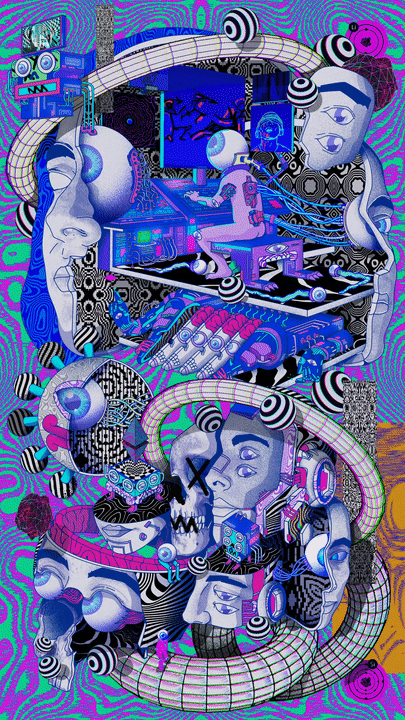IMN #7 — Luis Ponce

It's Monday Night #7
Tonight, let’s share thoughts about Luis Ponce‘s bizarre imaginary environments. My point is quite simple: with his collection of squared, glittering and fluorescent loops, Luis Ponce is mapping the fragmented ecology of the digital mind.
Everyday, the human eye becomes a little more outdated and irrelevant: machines have now learned to see by themselves and they only need us to ask, once in a while, for confirmation of what they see.
In every type of operating theaters (hospitals, factories, warfares, etc.), robots see and operate according to visual information they manage to capture. And this is actually not a value judgment, it is a fact. Anyway.
We – metropolitan animals – live in environments more and more controlled by the eye of the machine and we continue, within this world, to try to use our eyes. Fair enough. But what can we do with our eyes if we evolve in universes that are making them useless? You don’t look at a landscape but you show it to your phone; you no longer show your face to the customs officer but to a recognition software; etc., etc.
Of course, there are exceptions. But these are trends and at the level of generality I’m talking about, they transform our experience of love, tourism or work. It is not so much that our eyes are closed, but that the process of selection, interpretation and organization on which human vision is based has been delegated to machines. And this has led to a real anthropological turn.
Luis Ponce‘s work is a dark visual meditation on the future of the eye in the age of operational images.The decentering of human gaze is also an exile. But there is no way back. Go back where? There is nowhere to go back to when cybernetics does its job and loops are looped.
Each vignette signed Luis Ponce is a nauseous wandering in some landscape both constantly nocturnal and overexposed to light. This is where it gets really interesting.
Each piece of the collection puts in scene a derisory attempt to synthesize a meaningful picture, which turns out to be doomed to failure. The order of things is perfect but caught in a violent movement of dislocation and metamorphosis.
The perspective is distorted and yet there is no «trompe l’oeil». But there is no need for illusion either. Or rather: there is certainly the feeling of an illusion but the illusion itself is absent. It looks like a tarot card in which everything makes sense but no symbol can be fixed. And the interpretative machine is idle running.
In the works of Luis Ponce , there is only one eye, but it is both multiplied and decentred. At the same time, this eye is the same everywhere, an identical and immutable replica. A stereotype of an eye, who is no longer able to make sense of events that happen to it or contexts to which it belongs, even though everything works for the best in the best of worlds.
Have you heard of photosensitive epilepsy (PSE)? It is a form of epilepsy in which seizures are triggered by visual stimuli that form patterns in time or space, such as flashing lights; bold, regular patterns; or regular moving patterns (cf Wikipedia).
Before the crisis, what appears is an «aura», a perceptual disturbance that precedes the critical moment and in a way announces it. In this precise sense, I would qualify his work as «auratic»: namely, an incurable pathology that never develops into a fatal disease.
In Luis Ponce‘s work, there is the aura but there is no crisis and the epileptic eye opens in vain on the Black Lodge (for those who have watched Twin Peaks): auratic carousels without goals but working to perfection.
Foucault wrote somewhere : «Man is an invention of recent date. And one perhaps nearing its end», and added : «one can certainly wager that man would be erased, like a face drawn in sand at the edge of the sea.»
Luis Ponce tirelessly strives to reconstruct the fragmented face of sand after its complete disappearance.